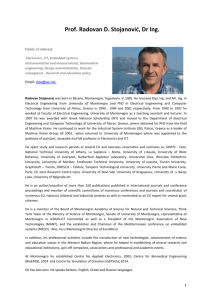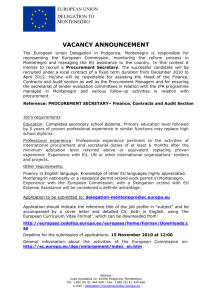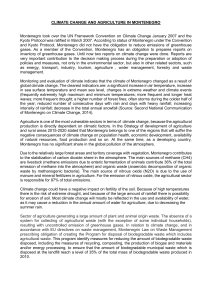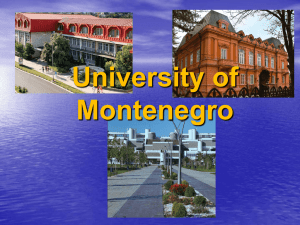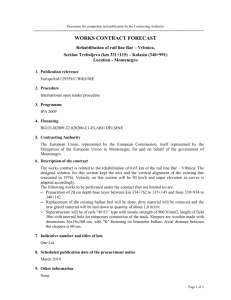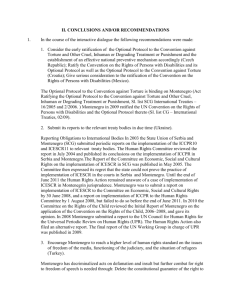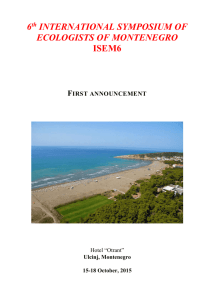Montenegro Country Report
advertisement
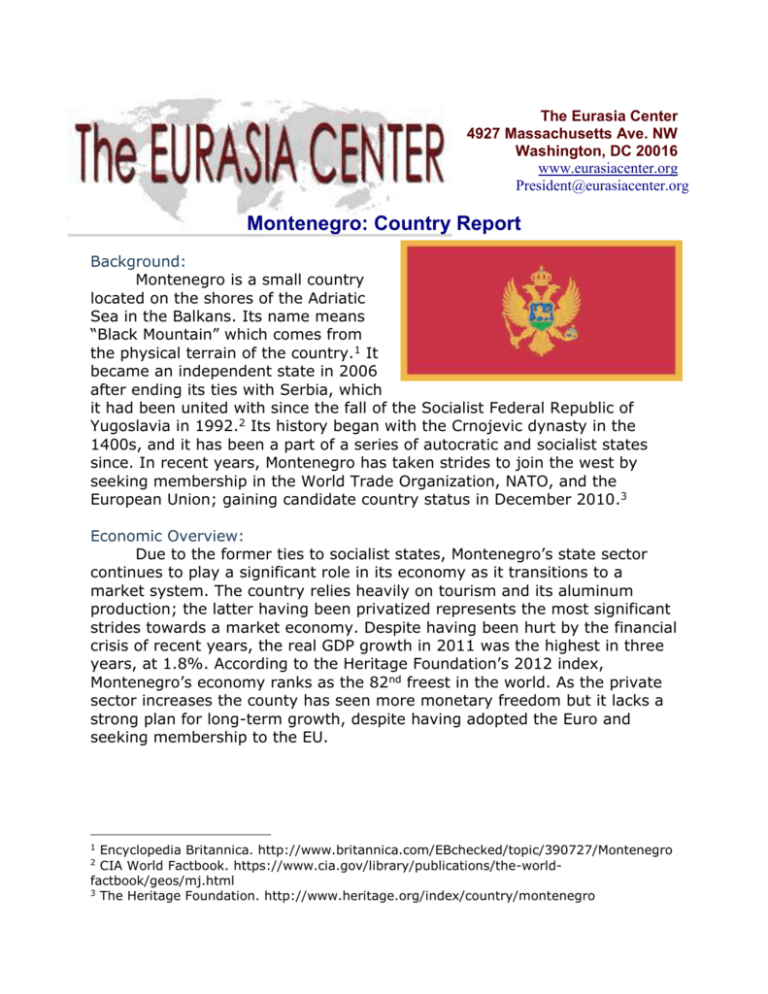
The Eurasia Center 4927 Massachusetts Ave. NW Washington, DC 20016 www.eurasiacenter.org President@eurasiacenter.org Montenegro: Country Report Background: Montenegro is a small country located on the shores of the Adriatic Sea in the Balkans. Its name means “Black Mountain” which comes from the physical terrain of the country.1 It became an independent state in 2006 after ending its ties with Serbia, which it had been united with since the fall of the Socialist Federal Republic of Yugoslavia in 1992.2 Its history began with the Crnojevic dynasty in the 1400s, and it has been a part of a series of autocratic and socialist states since. In recent years, Montenegro has taken strides to join the west by seeking membership in the World Trade Organization, NATO, and the European Union; gaining candidate country status in December 2010.3 Economic Overview: Due to the former ties to socialist states, Montenegro’s state sector continues to play a significant role in its economy as it transitions to a market system. The country relies heavily on tourism and its aluminum production; the latter having been privatized represents the most significant strides towards a market economy. Despite having been hurt by the financial crisis of recent years, the real GDP growth in 2011 was the highest in three years, at 1.8%. According to the Heritage Foundation’s 2012 index, Montenegro’s economy ranks as the 82nd freest in the world. As the private sector increases the county has seen more monetary freedom but it lacks a strong plan for long-term growth, despite having adopted the Euro and seeking membership to the EU. Encyclopedia Britannica. http://www.britannica.com/EBchecked/topic/390727/Montenegro CIA World Factbook. https://www.cia.gov/library/publications/the-worldfactbook/geos/mj.html 3 The Heritage Foundation. http://www.heritage.org/index/country/montenegro 1 2 Montenegro’s GDP for 2010 was $4.017 billion in US dollars, making it 147th in world rankings.4 Based on purchasing-power-parity, (PPP), the GDP in 2011 was estimated at $6.94 billion in US dollars, a 3.26% increase from 2010. Taxes – 29.1% of GDP (2011) Unemployment Rate: 11.5% (2011 estimate) Population below poverty line: 6.6% (2010 estimate) Public debt: 45% of GDP (2011 estimate) Budget deficit - -4.2% (2011)5 Economic Structure: 2011 estimates divide the country’s GDP into sectors; the largest being services with 62.9%, industry with 31.1%, and agriculture with 6.1%. Montenegro’s largest industries include aluminum, steelmaking, agricultural processing, consumer goods, and tourism. Agricultural products consist of tobacco, potatoes, citrus fruits, olives, grapes, and sheep. The country’s labor force consists of 3.27 billion people, 36.1% of whom work in agriculture, 21.5% in industry and 42.4% in services. The largest export partners of Montenegro are Serbia (17.5%), Hungary (16.9%), and Croatia (10.1%). Montenegro imports mostly from Serbia (28.4%), Greece (7.9%), and Bosnia and Herzegovina (7.6%).6 Attractions: Tourism in Montenegro has been growing in recent years, due to promotions of its natural beauty. Despite being a small country, Montenegro’s diverse geography, from the Prokletije mountains to the shores of the Adriatic, have drawn considerable attention.7 Montenegro has created itself as a business-friendly nation by privatizing many industries, and having the lowest corporate tax in its region.8 Economy Watch. http://www.economywatch.com/economicstatistics/Montenegro/GDP_Current_Prices_US_Dollars/ 5 Ibid. 6 CIA World Factbook. https://www.cia.gov/library/publications/the-worldfactbook/geos/mj.html 7 Montenegro Tourism. http://www.montenegro.travel/en/nature 8 US State Department. http://www.state.gov/r/pa/ei/bgn/70949.htm#econ 4 Trouble Spots: The budget balance has been negative in recent years, and public debt has climbed to almost 45 percent of GDP. Business and labor regulations have been inconsistent and require reforms if growth is to take place in the Montenegrin economy.9 The Judiciary branch of the government is regularly influenced by politics, going against its purpose as an independent body. Corruption in both this branch and the executive has led to a significant mistrust of the government.10 The rights of journalists to criticize the government have at times been infringed upon. In 2009 the mayor of Montenegro’s capital, Podgorica, assaulted two journalists because of their attempts to uncover abuses of power.11 Demographics: As of July 2012 Montenegro’s population is estimated at 657,394, with a growth rate of -0.633%. Based on a 2003 census, the nation’s ethnic groups consist of: Montenegrin 43%, Serbian 32%, Bosniak 8%, Albanian 5%, and other (Muslims, Croats, Roma (Gypsy) 12%. Serbian is the most widely spoken language, based on the 2003 census, with 63.6% of the population speaking it. The official language is Montenegrin with 22%, and other languages include; Bosnian at 5.5%, Albanian at 5.3%, and unspecified, which includes Croatian at 3.7%. Montenegrins are mostly Orthodox Christians; 74.2% of the population follows that religion, and Muslim, 17.7%. Other religions include Catholicism 3.5%, other 0.6%, unspecified 3%, and atheism 1%. Based on 2007 estimates there are 7,000 refugees of Serbian and Roma ethnicity who fled Kosovo to Montenegro.12 Environmental Concerns: Pollution of the water in the Bay of Kotor is the most significant concern, not only for environmental considerations but also because that region attracts the most tourists.13 Acknowledgements: Research and Data Development Provided by: Francisco Perez, Associate, Under the Supervision and Coordination of: Dr. Gerard J. Janco, President, Eurasia Center/Eurasian Business Coalition. The Heritage Foundation. http://www.heritage.org/index/country/montenegro Ibid. 11 Freedom House. http://www.freedomhouse.org/report/freedom-world/2011/montenegro 12 CIA World Factbook. https://www.cia.gov/library/publications/the-worldfactbook/geos/mj.html 13 Ibid. 9 10
